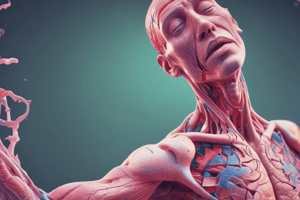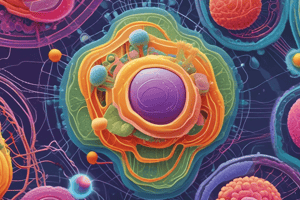Podcast
Questions and Answers
What is the study of heredity and inherited traits?
What is the study of heredity and inherited traits?
- Epigenetics
- Phenetics
- Genetics (correct)
- Paleogenetics
Which component of the cell encodes proteins that facilitate biological processes?
Which component of the cell encodes proteins that facilitate biological processes?
- Mitochondria
- Chromosomes
- Genes (correct)
- RNA
What is the main function of epithelial tissue?
What is the main function of epithelial tissue?
- Produce movement
- Cover body surfaces and secrete substances (correct)
- Maintain posture
- Support movement
Which tissue type provides structural support and contains immune cells?
Which tissue type provides structural support and contains immune cells?
What does DNA encode in the context of genetics?
What does DNA encode in the context of genetics?
True or False: Tissues are the basic functional units of multicellular organisms.
True or False: Tissues are the basic functional units of multicellular organisms.
What is the role of nervous tissues?
What is the role of nervous tissues?
Which type of tissue contains just one cell type?
Which type of tissue contains just one cell type?
Which genes are associated with breast and ovarian cancer?
Which genes are associated with breast and ovarian cancer?
How are genetics and tissue structures interconnected?
How are genetics and tissue structures interconnected?
How have discoveries in genetics and tissues impacted medicine?
How have discoveries in genetics and tissues impacted medicine?
What insights have investigations into genetics and tissues provided about human diseases?
What insights have investigations into genetics and tissues provided about human diseases?
Flashcards are hidden until you start studying
Study Notes
Biology: Exploring Genetics and Tissue Structures
Biology encompasses a wide range of topics, from the fundamentals of life to the complex mechanisms that govern living organisms. In this article, we will delve into the intriguing interplay between genetics and tissue structures, shedding light on the molecular basis of life and the functional organization of tissues.
Genetics: The Language of Life
Genetics is the study of heredity and the variation of inherited traits. At its core lies the concept of DNA, the blueprint of life, and the genes, the functional units that determine an organism's characteristics. Genes are sequential segments of DNA that encode proteins, which in turn facilitate various biological processes.
Genetics has evolved through the decades, from the rediscovery of Gregor Mendel's laws of inheritance in the early 20th century to modern techniques like CRISPR/Cas9, which offers precise control over genetic modifications.
Tissue Structures: The Building Blocks of Life
Tissues are groups of cells that work together to perform a specific function. They form the basic structural and functional units of multicellular organisms. There are four main types of tissues:
- Epithelial: Covers body surfaces, lines internal cavities, and secretes substances.
- Connective: Provides structural support, facilitates transportation, and contains immune cells.
- Muscle: Produces movement and maintains posture.
- Nervous: Transmits signals, regulates body activities, and coordinates responses.
Tissues are further categorized into simple (contain just one cell type) and complex (contain multiple cell types), such as the cardiac muscle tissue, which is a complex, striated, multinucleated muscle fiber.
Genetics and Tissue Interplay
Genetics and tissue structures are inextricably interconnected. The genetic information encoded in DNA determines the properties of cells, which in turn dictate the characteristics and functions of tissues. For example, mutations in genes that control collagen synthesis can lead to connective tissue disorders like Ehlers-Danlos syndrome, where the body's connective tissue is weaker than normal.
Investigations into genetics and tissues have led to profound insights into human diseases, such as the role of BRCA1 and BRCA2 genes in breast and ovarian cancer, and the understanding of the molecular basis of neurodegenerative diseases like Alzheimer's and Parkinson's. These discoveries have opened new avenues for diagnosis, treatment, and prevention of diseases.
Conclusion
The intricate dance between genetics and tissue structures lies at the heart of biology, revealing the inner workings of life and the mysteries of the natural world. As we delve deeper into the secrets of the genetic code and the functional organization of tissues, we gain a better understanding of the complexities of life and the possibilities of shaping the future of biology.
Studying That Suits You
Use AI to generate personalized quizzes and flashcards to suit your learning preferences.




